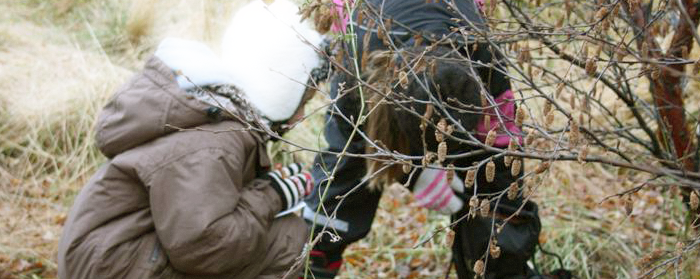Bækur
Guðmundur Pálsson
2014-08-19T09:52:38+00:00
Bækur um útikennslu
Hér að neðan er listi yfir ýmsar bækur sem fjalla um útikennslu. Flestar þeirra má finna í Gegnir.is og þar kemur fram hvaða bókasöfn eiga þær í safnkosti sínum.
- Andreassen, I. & Grimsæth, G. (2007). Ut på tunet. Opplæring på gård. Bergen: Høgskolen i Bergen.
- Beams, S. (2012). Learning outside the classroom: theory and guidelines for practice. New York: Routledge.
- Bennett, J.( 2003). Teaching and Learning science. New York: Continuum.
- Benedict, F. (ritstj.). (1991). Environmental Education for Our Common Future. A Handbook for Teachers in Europe. Oslo: Norwegian University Press.
- Bourne, B. (ritstj). (2000). Taking inquiry outdoors. Reading, writing, and science beyond the classroom walls. Portland: Stenhouse Publishers.
- Brage, C. (2012). Teaching technology outdoors. Linköping: Carina Brage.
- Braund, M. & Reiss, M. (2004). Learning Science outside the classroom. London: Routledge Falmer.
- Broda, H. W. (2007). Schoolyard-enhanced learning: using the outdoors as an instructional tool, K–8. Portland: Stenhouse Publishers.
- Broda, H. W. (2011). Moving the classroom outdorrs: schoolyeard-enhanced learning in action. Portland: Stenhouse Publishers.
- Brügge, B., Glantz, M. & Sandell, K. (2011). Friluftslivets pedagogik. En miljö- och utomhuspedagogik för kunskap, känsla och livskvalitet. Stokkhólmur: Liber AB.
- Bunting, C. J. (2006). Interdisciplinary teaching through outdoor education. Champaign: Human Kinetics.
- Caton, D. (2006). New approaches to fieldwork. Sheffield: Geographical Assocation.
- Dahlgren, L., S. Sjölander, J., Strid, P & Szczepanski, A. (ritstj.). (2007). Utomhuspedagogik som kunskapskälla. Närmiljö blir lärmiljö. Lund: Studentlitteratur.
- Dowden, D. (2009). Teachnically geography: lessons combining geogarphy and ICT for Y5/6. Sheffield: Geogarphical Association. Drougge, S., Kranse, C., Skoglund, L., Bergner, S., Guter, H., Westerlund, A. & Lindahl, A.
- (2007). I ur och skur i skolan. En handledning från Friluftsfrämjandet. Stockholm: Friluftsfrämjandet.
- Ericsson, G. (2002). Lära ute. Upplevelser och lärande i naturen. Stockhom: Friluftsfrämjandet.
- French, S. (1994). Outdoor maths. Christchurch: User friendly resource.
- Gilbertson, K. (2006). Outdoor education: methods and strategies. Champaign: Human Kinetics.
- Glascott Burriss, K. & Foulks Boyd, B. (ritstj.). (2005). Outdoor learning and play, ages 8–12. Olney: Association for childhood education international.
- Hammerman, D. R. (2001). Teaching in the outdoors. Danville: Interstate Publishers.
- Higgins, P. & Nicole, R. (2002). Outdoor education: authentic learning in the context of landscapes. Kisa: Kinda education.
- Holmes, D. (2000). A–Z advancing geography: Fieldwork. Sheffield: Geographical Association.
- Hopkins, D. (2012). The adventure learning schools handbook. Stockport: The Adventury learning schools.
- Humberstone, B. (2000). Her outdoors: risk, challenge and adventure in gendered open spaces. Eastbourne: Leisure studies association.
- Jeffrey, B. & Woods, P. (2003). The Creative School. A framework for success, quality and effectiveness. London: RoutledgeFalmer.
- Jordet, A. N. (2010). Klasserommet utenfor. Oslo: Cappelen Akademisk Forlag.
- Kirkland, J. (2007). No student left indoors: creating a field guide to your schoolyard. Lionville: Stillwater Publishing.
- Kvammen, P.I., Lie, S., Nyhus, G, Vedum, T. & Ødegaard, T. (2014). Oppdag naturen. Bergen: Fagbokforlaget.
- Lysklett, O. B. (2008). Ute hele uka. Natur- og friluftsbarnehagen. Oslo: Universitetsforlaget.
- Leat, D. (ritstj.) (2001). Thinking through geogarphy. Cambridge: Chris Kington Publ.
- Leeder, A. (2006). 100 iedas for teaching geogarphy. London: Continuum.
- Martin, F. (2006). Teaching geography in primary schools; learning to live in the world. Cambridge: Chris Kington Publ.
- Nichols, A. (ritstj.). (2001). More thinking through geography. Cambridge: Chris Kington Publ.
- Ogilvie, K. C. (2005). Leading and managing groups in the outdoors. Penrith: Institude for outdoor learning.
- Out of Classroom Learning. (2006). England: Education & skills select committee.
- Owen, D. &Ryan, A. (2001). Teaching geography 3-11, the essential guide. London: Continuum.
- Redmond, K. (2010). Quality lesson plans for outdoor education. Champaign: Human Kinetics.
- Robertson, J. (2014). Dirty teaching: a beginner‘s guide to learning outdoors. Bancyfelin: Independent Thinking Press.
- Ros, G. (2009). Playing outdoors in the early years. London: Continuum
- Ryder Richardson, G. (2006). Creating a space to grow: developing your outdoor learning environment. London: David Fulton.
- Scoffham, S. (ritstj.). (2010). Primary Geographer handbook. Sheffield: Geographical Association.
- Sobel, D. (1998). Mapmaking with children: sense-of-place education. Portsmouth: Heinemann.
- Sobel, D. (2004). Place-based education: connecting classrooms & communities. Great Barrington: Orion Society.
- Steffen, J. (2003). Assessment in outdoor/adventure physical education. Reston: National association for sports and physical education.
- Tovey, H. (2007). Playing outdoors: spaces and places, risk and challenge. Maidenhead: Open University Press.
- Twomey, M. (2001). That‘s me! Dyslexia & outdoor learning. S.I.: Pathways.
- Wiegand, P. (2006). Learning and teaching with maps. London: Routledge.
- Williams, A. & Tucker-Welton, N. (ritstj.). Landscape, youth and outdoor education: what are we doing? What should we be doing? Wales: Trinity College.

